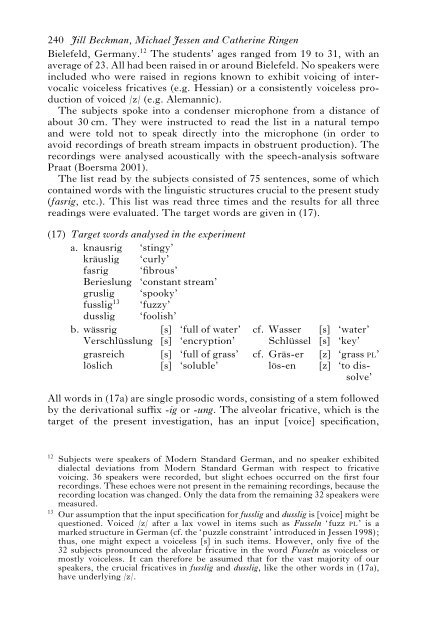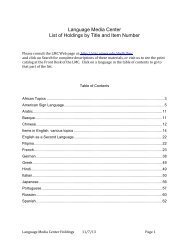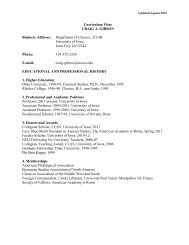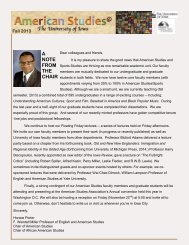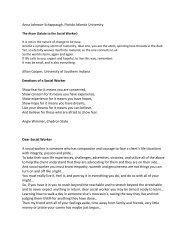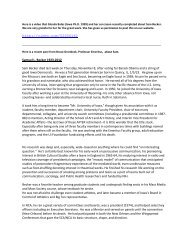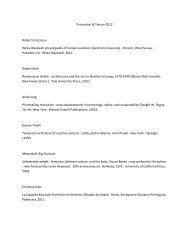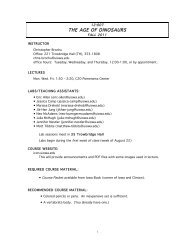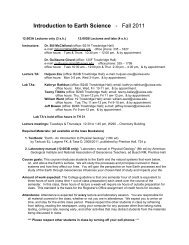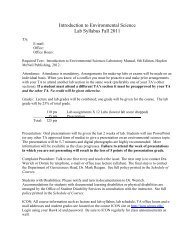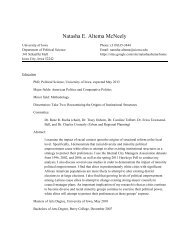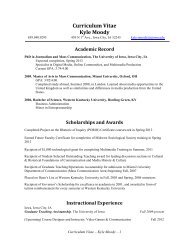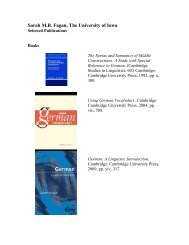German fricatives: coda devoicing or positional faithfulness?
German fricatives: coda devoicing or positional faithfulness?
German fricatives: coda devoicing or positional faithfulness?
You also want an ePaper? Increase the reach of your titles
YUMPU automatically turns print PDFs into web optimized ePapers that Google loves.
240 Jill Beckman, Michael Jessen and Catherine Ringen<br />
Bielefeld, <strong>German</strong>y.12 The students’ ages ranged from 19 to 31, with an<br />
average of 23. All had been raised in <strong>or</strong> around Bielefeld. No speakers were<br />
included who were raised in regions known to exhibit voicing of intervocalic<br />
voiceless <strong>fricatives</strong> (e.g. Hessian) <strong>or</strong> a consistently voiceless production<br />
of voiced /z/ (e.g. Alemannic).<br />
The subjects spoke into a condenser microphone from a distance of<br />
about 30 cm. They were instructed to read the list in a natural tempo<br />
and were told not to speak directly into the microphone (in <strong>or</strong>der to<br />
avoid rec<strong>or</strong>dings of breath stream impacts in obstruent production). The<br />
rec<strong>or</strong>dings were analysed acoustically with the speech-analysis software<br />
Praat (Boersma 2001).<br />
The list read by the subjects consisted of 75 sentences, some of which<br />
contained w<strong>or</strong>ds with the linguistic structures crucial to the present study<br />
(fasrig, etc.). This list was read three times and the results f<strong>or</strong> all three<br />
readings were evaluated. The target w<strong>or</strong>ds are given in (17).<br />
(17)<br />
Target w<strong>or</strong>ds analysed in the experiment<br />
a. knausrig ‘stingy’<br />
kräuslig ‘curly’<br />
fasrig ‘fibrous’<br />
Berieslung ‘constant stream’<br />
gruslig ‘spooky’<br />
fusslig13 ‘fuzzy’<br />
dusslig ‘foolish’<br />
b. wässrig<br />
Verschlüsslung<br />
[s]<br />
[s]<br />
‘full of water’<br />
‘encryption’<br />
grasreich<br />
löslich<br />
[s]<br />
[s]<br />
‘full of grass’<br />
‘soluble’<br />
cf.<br />
cf.<br />
Wasser<br />
Schlüssel<br />
Gräs-er<br />
lös-en<br />
[s] ‘water’<br />
[s] ‘key’<br />
[z] ‘grass pl’<br />
[z] ‘to dissolve’<br />
All w<strong>or</strong>ds in (17a) are single prosodic w<strong>or</strong>ds, consisting of a stem followed<br />
by the derivational suffix -ig <strong>or</strong> -ung. The alveolar fricative, which is the<br />
target of the present investigation, has an input [voice] specification,<br />
12 Subjects were speakers of Modern Standard <strong>German</strong>, and no speaker exhibited<br />
dialectal deviations from Modern Standard <strong>German</strong> with respect to fricative<br />
voicing. 36 speakers were rec<strong>or</strong>ded, but slight echoes occurred on the first four<br />
rec<strong>or</strong>dings. These echoes were not present in the remaining rec<strong>or</strong>dings, because the<br />
rec<strong>or</strong>ding location was changed. Only the data from the remaining 32 speakers were<br />
measured.<br />
13 Our assumption that the input specification f<strong>or</strong> fusslig and dusslig is [voice] might be<br />
questioned. Voiced /z/ after a lax vowel in items such as Fusseln ‘fuzz PL’ is a<br />
marked structure in <strong>German</strong> (cf. the ‘puzzle constraint’ introduced in Jessen 1998);<br />
thus, one might expect a voiceless [s] in such items. However, only five of the<br />
32 subjects pronounced the alveolar fricative in the w<strong>or</strong>d Fusseln as voiceless <strong>or</strong><br />
mostly voiceless. It can theref<strong>or</strong>e be assumed that f<strong>or</strong> the vast maj<strong>or</strong>ity of our<br />
speakers, the crucial <strong>fricatives</strong> in fusslig and dusslig, like the other w<strong>or</strong>ds in (17a),<br />
have underlying /z/.


